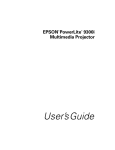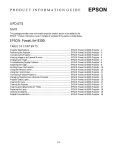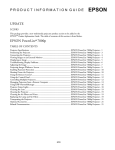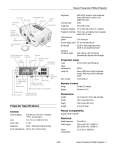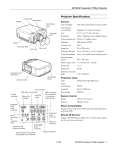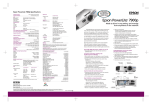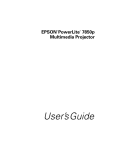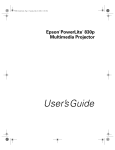Download Epson PowerLite 9300i Specifications
Transcript
EPSON PowerLite 9300i Projector Projector Specifications Control panel Indicator lights Speaker General Type of display Poly-silicon Thin Film Transistor (TFT), active matrix Size of LCD panels Diagonal: 1.4 inch (35.6 mm) Lens F=1.7 to 2.2, f=53 to 72 mm Resolution 1400 × 1050 pixels (SXGA+) (native format) Color reproduction 24 bit, 16.8 million colors Handle IR receiver Foot release lever Brightness Approx. 2500 ANSI lumens Contrast ratio 1100:1 (in dynamic color mode) Image size 22 to 300 inches Projection distance 3.6 to 49.2 feet (1.1 to 15 meters) Adjustable foot Lens cover Projection methods Front, rear, upside-down front (ceiling mount), and upside-down rear Internal sound system Network port DVI-D port (dual-link DVI) Optical aspect ratio 4:3 (horizontal:vertical); supports 16:9 and 5:4 Computer 1 Computer 2 port port USB port BNC ports (component video) 7 W monaural Video port (composite video) Zoom ratio 1:1.35 Noise level 33 dB Keystone correction angle ±40° vertical ±20° horizontal Projection Lamp Type UHE (Ultra High Efficiency) Power consumption 200 W S-Video port Control port (RS-232C) Hardwired remote control cable port Monitor Out port Audio Out port Note: Independent audio input connectors are provided for each computer and video port. Lamp life Up to 7000 hours Part number V13H010L26 Remote Control Range about 30 feet (10 meters) Battery AA × 2 Mouse compatibility Supports USB mouse 10/03 EPSON PowerLite 9300i Projector - 1 EPSON PowerLite 9300i Projector Compatible Video Formats Dimensions Height 7.6 inches (193 mm) including feet Width 13.9 inches (352 mm) Depth 19.3 inches (491 mm) Weight 24.7 lb (11.2 kg) (with lens) The projector supports these international video standards: Electrical Rated frequency 50 to 60 Hz Power supply 100 to 120 VAC, 5.4 A 200 to 240 VAC, 2.5 A Power consumption You can use any of the following video sources: VCR, DVD player, camcorder, digital camera, gaming console, or laser disc player. The projector supports composite video, S-video, component video, and RGB video, and it automatically senses the video format (HDTV, NTSC, PAL, or SECAM). Mode Refresh Rate (Hz) NTSC 60 NTSC 4:3 60 PAL 50 M-PAL 60 N-PAL 50 PAL—60 60 SECAM 50 HDTV (720p) 60 HDTV (720p) 50 HDTV (1080i) 60 Operating: 20 to 80% RH, non-condensing HDTV (1080i) 50 SDTV (480p) 60 Storage: 10 to 90% RH, non-condensing SDTV (480p) 50 TV (525i) 60 TV (625i) 50 Operating: 340 W Standby mode: 1.8 W (network off) Standby (network on): 60 W Environmental Temperature Operating: 41 to 104 °F (5 to 40°C) Storage: 14 to 140 °F (–10 to 60 °C) Humidity Safety United States FCC 47CFR Part15B Class B (DoC) UL1950 Rev. 3 Canada ICES-003 Class B CSA C22.2 No. 950-95 (cUL) CE Marking Directive 73/23/EEC, 89/336/EEC EN 55022, EN 55024 Computer Port Pin Assignments The Computer1, Computer 2, and Monitor Out ports are female video RGB, 15-pin D-sub connectors. Pin no. Signal Pin no. Signal 1 Red video 9 Reserved 2 Green video 10 Synchronous GND 3 Blue video 11 GND 4 GND 12 SDA 5 GND 13 Horizontal sync/ composite sync 6 Red GND 14 Vertical sync 7 Green GND 15 SCL 8 Compatible Computer Display Formats You can connect the projector to a wide range of computers, including PCs and notebooks, Apple Macintosh,® Power Macintosh® series (including G3, G4, and G5 systems), PowerBook® computers, many iMac® and iBook® series systems, and high-end workstations such as the Sun® SPARCstation.™ Although images are displayed at the projector’s native resolution of 1400 × 1050 pixels, EPSON’s patented SizeWise™ chip supports computer display formats ranging from VGA through UXGA. To project images output from a computer, the computer’s external monitor signal must be set at a refresh rate (vertical frequency) that’s compatible with the projector; see the following table for compatible formats. For best results, the computer’s resolution should be set to match the projector’s native SXGA+ resolution (1400 × 1050). Blue GND 2 - EPSON PowerLite 9300i Projector 10/03 Mode Refresh Rate (Hz) Resolution VGA-EGA 70 640 × 350 VGA—60 60 640 × 480 VESA—72 72 640 × 480 VESA—75 75 640 × 480 VESA—85 85 640 × 480 VGA—120 120 640 × 480 EPSON PowerLite 9300i Projector Mode Refresh Rate (Hz) Resolution SVGA—56 56 800 × 600 SVGA—60 60 800 × 600 SVGA—72 72 800 × 600 SVGA—75 75 800 × 600 SVGA—85 85 800 × 600 SVGA—120 120 800 × 600 XGA—43i 86 1024 × 768 XGA—60 60 1024 × 768 XGA—70 70 1024 × 768 XGA—75 75 1024 × 768 XGA—85 85 1024 × 768 XGA—120 120 1024 × 768 SXGA1—70 70 1152 × 864 SXGA1—75 75 1152 × 864 SXGA1—85 85 1152 × 864 SXGA1—100 100 1152 × 864 SXGA2—60 60 1280 × 960 SXGA2—75 75 1280 × 960 SXGA2—85 85 1280 × 960 SXGA3—43i 86 1280 × 1024 SXGA3—60 60 1280 × 1024 SXGA3—75 75 1280 × 1024 SXGA3—85 85 1280 × 1024 SXGA+60 60 1400 × 1050 SXGA+75 75 1400 × 1050 SXGA+85 85 1400 × 1050 UXGA—48i 96 1600 × 1200 UXGA—60 60 1600 × 1200 UXGA—65 65 1600 × 1200 UXGA—70 70 1600 × 1200 UXGA—75 75 1600 × 1200 UXGA—80 80 1600 × 1200 UXGA—85 85 1600 × 1200 iMAC VGA 117 640 × 480 iMAC SVGA 95 800 × 600 iMAC XGA 75 1024 × 768 MAC13 67 640 × 480 MAC16 75 832 × 624 MAC19—60 59 1024 × 768 MAC19 75 1024 × 768 MAC21 75 1152 × 870 Positioning the Projector ❏ Place the projector on a sturdy, level surface. ❏ Make sure there is plenty of space for ventilation around and under the projector. Do not set the projector on top of loose papers that could block the vents under the projector. ❏ Make sure the projector is within 10 feet of a grounded electrical outlet or extension cord. Image size increases with distance, but varies depending on how you’ve adjusted the optical zoom and other settings. TBD 37 to 50 ft 7 to 10 ft 3 to 5 ft approx. distance from screen It’s best to place the projector directly in front of the center of the screen, facing the screen squarely. If it isn’t placed this way, the image will be “keystone” shaped, instead of square or rectangular. If this happens, you can use the projector’s keystone buttons (see page 9) or QuickCorner™ function to correct the image shape (see page 10). Projector Screen Overhead View If you place the projector between the top and bottom of the screen, you can use the Lens Shift to raise or lower the image (see page 9). Screen Ideal height Side View If you place the projector below screen level, you’ll have to tilt it up by extending its feet. This causes the image to lose its square shape, but you can correct the distortion by pressing the Keystone button as described on page 9. 10/03 EPSON PowerLite 9300i Projector - 3 EPSON PowerLite 9300i Projector ❏ Distance at Tele setting (inches) = (diagonal screen size [inches] × 7.6049 - 13.3501)/2.54 Distance and Screen Size Calculations Use the calculations below to determine the how far to place the projector from the screen and the size of the screen. To find a screen’s diagonal size when you know the distance: Standard Zoom Lens (V12H004S02) To find the distance when you know the screen’s diagonal size: ❏ Screen size at Wide setting (inches) = (projection distance [inches] × 2.54 × 0.199018 + 2.689217) ❏ Distance at Wide setting (inches) = (diagonal screen size [inches] × 3.7857 - 9.6813)/2.54 ❏ Screen size at Tele setting (inches) = (projection distance [inches] × 2.54 × 0.131494 + 1.75546) ❏ Distance at Tele setting (inches) = (diagonal screen size [inches] × 5.175 - 9.5418)/2.54 Middle Throw Zoom Lens (V12H004M02) To find the distance when you know the screen’s diagonal size: To find a screen’s diagonal size when you know the distance: ❏ Distance at Wide setting (inches) = (diagonal screen size [inches] × 7.409 - 14.5823)/2.54 ❏ Screen size at Wide setting (inches) = (projection distance [inches] × 0.264152 × 2.54) + 2.557334 ❏ Distance at Tele setting (inches) = (diagonal screen size [inches] × 11.2032 - 14.8525)/2.54 ❏ Screen size at Tele setting (inches) = (projection distance [inches] × 0.193237 × 2.54) + 1.843826 To find a screen’s diagonal size when you know the distance: ❏ Screen size at Wide setting (inches) = (projection distance [inches] × 2.54 × 0.134971 + 1.968187) Rear Projection Wide Lens (V12H004R02) To find the distance when you know the screen’s diagonal size: ❏ Screen size at Tele setting (inches) = (projection distance [inches] × 2.54 × 0.08926 + 1.323702) ❏ Distance (inches) = (diagonal screen size [inches] × 1.81553 - 6.59805)/2.54 Long Throw Zoom Lens (V12H004L04) To find a screen’s diagonal size when you know the distance: To find the distance when you know the screen’s diagonal size: ❏ Screen size (inches) = projection distance [inches] × 2.54 × 0.5508024 + 3.634232 ❏ Distance at Wide setting (inches) = (diagonal screen size [inches] × 10.6703 +14.1243)/2.54 ❏ Distance at Tele setting (inches) = (diagonal screen size [inches] × 14.407 + 13.343)/2.54 Wide Zoom Lens (V12H004W02) To find the distance when you know the screen’s diagonal size: To find a screen’s diagonal size when you know the distance: ❏ Screen size at Wide setting (inches) = (projection distance [inches] × 2.54 × 0.093718 1.323702) ❏ Distance at Wide setting (inches) = (diagonal screen size [inches] × 2.68681 - 6.80456)/2.54 ❏ Distance at Tele setting (inches) = (diagonal screen size [inches] × 3.80739 - 6.46563)/2.54 ❏ Screen size at Tele setting (inches) = (projection distance [inches] × 2.54 × 0.069411 0.926168) To find a screen’s diagonal size when you know the distance: ❏ Screen size at Wide setting (inches) = (projection distance [inches] × 2.54 × 0.372189 + 2.53258) ❏ Screen size at Tele setting (inches) = (projection distance [inches] × 2.54 × 0.262647 + 1.698179) Middle Throw Zoom Lens (V12H004M01) To find the distance when you know the screen’s diagonal size: ❏ Distance at Wide setting (inches) = (diagonal screen size [inches] × 5.02466 - 13.5124)/2.54 4 - EPSON PowerLite 9300i Projector 10/03 EPSON PowerLite 9300i Projector Connecting the Projector You can connect the projector to four computer sources or five video sources—up to a total of six sources altogether. You can include an independent sound channel for each of the six sources. Type of connections The following types of connections are possible, depending on the kinds of signals your equipment generates and its available output ports: Viewing Images on an External Monitor You can use an external monitor to display images from any connected computer or video source. This lets you view your presentation close-up, as well as on the projection screen. Note: Some LCD monitors may not be able to display the image correctly. If you have trouble displaying the image, connect a multiscan monitor. If you’re projecting computer images, make sure the computer’s refresh rate is set to 65 Hz or greater. To use an external monitor, connect it to the projector’s Monitor Out port, as shown: Computer equipment Output signal Required cable Analog RGB video VGA cable BNC cable VGA-to-BNC cable DVI DVI-D dual-link cable (DVI-to-DVI or DFP-to-DVI available from EPSON) External monitor Video equipment Output signal Required cable Composite video RCA video cable S-video S-video cable Component video— NTSC (YCbCr) BNC cable Follow these guidelines when using an external monitor: Component video— HDTV (YPbPr) BNC cable RGB video VGA cable BNC cable ❏ The monitor displays the currently selected video source. Press the Preview button if you want to display all the active sources at once (see page 7). Note that the projector’s Computer 1, Computer 2, and BNC ports accept a variety of input signals. If you’re connecting to one of these ports, you’ll need to make sure that the correct input signal setting is selected, or your image won’t display properly. To change the input signal setting, do the following: ❏ If you want, you can view (or preview) images on the monitor while the projection screen is darkened after pressing the A/V Mute button. ❏ You can also view images on the monitor while the projector is in standby mode (plugged in but not turned on), if the Standby Mode setting has been set to Network ON in the Advanced1 menu. 1. After turning on the projector, press the Menu button. The menu screen appears. 2. Select the Setting menu. 3. Change the Computer 1 Input, Computer 2 Input, or BNC Input setting, as needed, to match the signal generated by your computer or video equipment. 10/03 EPSON PowerLite 9300i Projector - 5 EPSON PowerLite 9300i Projector Displaying an Image If you turn on your computer or video equipment before turning on the projector, the projector will automatically select the connected source. If you have multiple sources connected, you may have to switch to the desired source manually (see “Selecting the Image Source” at right). Selecting the Image Source You can use the source buttons either on the projector or the remote control: ❏ The projector has two Source buttons. Use the Computer/DVI button to switch between equipment connected to the Computer 1, Computer 2, and DVI ports. Use the Video/BNC button to switch between equipment connected to the Video, S-Video, and BNC ports. Turning On the Projector 1. Remove the lens cap. Caution: Do not use the projector with the lens cap in place. The heat generated by the lens can damage the cap. 2. Connect the power cord to the projector, then plug the other end into a grounded electrical outlet. 3. Wait a few seconds until the P power light to turns orange. 4. Press the red P Power button on top of the projector. You can also use the P Power button on the remote control. Power button ❏ The remote control has seven Source buttons. Use them to switch between equipment connected to the port identified on each button. If you’re using the remote control, make sure batteries are installed and the power switch on the side of the remote control is turned on. The P power light flashes green as the projector warms up, and an image begins to appear after about 30 seconds. When the power light stops flashing and remains green (in about 40 seconds), the projector is ready for use. If you’ve enabled password protect, enter your password at the prompt. Note: You can preview all sources to help you select the desired source (see page 7). Warning: Never look into the lens when the lamp is on. This can damage your eyes. Note: To shut down the projector, see page 10. Shutting down the projector correctly prevents premature lamp failure and possible damage from overheating. 6 - EPSON PowerLite 9300i Projector 10/03 EPSON PowerLite 9300i Projector Previewing Image Sources You can use the Preview function to help you select the image source. 1. Press Preview on the remote control. Troubleshooting Display Problems Follow these guidelines if you’re having trouble displaying an image. You Can’t Project an Image If you see a blank screen or a blue screen with the No Signal message, try the following: Preview ❏ Make sure the cables are connected correctly. ❏ Make sure the power light is green and not flashing and the lens cover is off. ❏ If you’ve connected more than one computer and/or video source, you may need to press one of the Source buttons on the projector’s control panel or the remote control to select the correct source. (Allow a few seconds for the projector to sync up after pressing the button.) You see the currently selected source displayed in the main window, as shown below. All sources (including the currently selected source) are displayed in smaller preview windows on the right side and at the bottom. If no equipment is connected to a port, or if there is no incoming signal, the preview window for that source appears blank. ❏ If you’re using a Windows/PC notebook, press the function key on your keyboard that lets you display on an external monitor. It may be labeled CRT/LCD or have an icon such as . You may have to hold down the Fn key while pressing it. Allow a few seconds for the projector to sync up after changing the setting. Note: Movies are displayed as still images on the preview screen. The Projector and Notebook Don’t Display the Same Image If you’re projecting from a notebook, and you don’t see the same image on the projection screen and on your computer screen, follow these guidelines. Currently selected source If you’re using a Windows/PC notebook: ❏ On most systems, there’s a function key that lets you toggle between the LCD screen and the projector, or display on both at the same time. It may be labeled CRT/LCD or with an icon such as . You may have to hold down the Fn key while pressing it. Allow a few seconds for the projector to sync up after changing the setting. Preview windows 2. Press one of the Source buttons on the remote control to switch to the desired source. Or press ESC to exit the preview screen without switching sources. Note: A red highlight surrounds the preview window for the currently selected source. You can use the pointer button on the remote control to highlight a different source, and then press Enter to display it. ❏ If the function key doesn’t permit you to display simultaneously on both screens, you should check your monitor settings to make sure both the LCD screen and the external monitor port are enabled. 1. From the Control Panel, open the Display utility. 2. In the Display Properties dialog box, click the Settings tab, then click Advanced. 3. The method for adjusting the settings varies by brand; you may need to click a Monitor tab, then make sure the external Monitor port is set as your primary display and/or enabled. See your computer’s documentation or online help for details. 10/03 EPSON PowerLite 9300i Projector - 7 EPSON PowerLite 9300i Projector If you're using Macintosh OS X: You may need to set up your system to display on the projector screen as well as the LCD screen. Follow these steps: If the Arrange option isn’t available, you may need to select one of the Simulscan resolution settings: 1. Click the Monitor icon. 1. From the Apple menu, select System Preferences, then select Displays. Click here 2. Make sure the VGA Display or Color LCD dialog box is selected. 3. Click the Arrange (or Arrangement) tab. Select the VGA Display dialog box Select a Simulscan resolution 2. Select a Simulscan resolution as shown. (Allow a few seconds for the projector to sync up after making the selection.) Adjusting the Image Make sure Mirror Displays is checked Once you see your image, you may need to make certain adjustments. 4. Make sure the Mirror Displays checkbox is selected. If you’re using OS 8.6 to 9.x: You may need to set up your system to display on the projector screen as well as the LCD screen. Follow these steps: 1. From the Apple menu, select Control Panels, then click Monitors or Monitors and Sound. Focusing and Zooming Your Image Use the Focus buttons on the remote control (or on the projector) to sharpen the image. Use the Zoom buttons to reduce or enlarge the image. 2. Click the Arrange icon. Click here Focus Drag one monitor icon on top of the other 3. Drag one monitor icon on top of the other. 8 - EPSON PowerLite 9300i Projector Zoom If the image still isn’t large enough, you may need to move the projector farther away from the screen. You can also use the E-Zoom buttons on the remote control to zoom in on a portion of the image. Note: The Focus and Zoom buttons won’t work when the wideangle rear projection lens is installed. 10/03 EPSON PowerLite 9300i Projector Adjusting the Height of Your Image Adjusting the Image Shape If the image is too low on the screen, you can raise it using the Lens Shift. This is the best method for adjusting the height of the image. If you need to raise the image further, you can tilt the projector upward by extending the feet. In most cases, you can maintain a square or rectangular image by placing the projector directly in front of the center of the screen and using the Lens Shift (instead of tilting the projector upward) to adjust the image height. Using the Lens Shift If this isn’t possible, use one of these methods to correct the image shape: To raise or lower the image, use the Lens Shift buttons on the remote control (or on the projector). Lens Shift ❏ If the image tapers inward on the right and left sides only, use Keystone correction as described on the next page. ❏ If the image looks uneven on all sides, or just on the top and bottom, you can adjust its shape using QuickCorner. You cannot use both Keystone correction and QuickCorner at the same time. Note: The Lens Shift buttons won’t work when the wide-angle rear projection lens is installed. Raising the Projector’s Feet If you need to raise the image further, you can incline the projector: Using Keystone Correction To adjust your image when the right and left sides are uneven, do one of the following: ❏ Use the Keystone buttons on the projector’s control panel to adjust the image shape. 1. Stand behind the projector. Press the foot release buttons on each side and lift the front of the projector. 2. Once the image is positioned where you want it, release the buttons to lock the feet in position. Keystone buttons ❏ Or use the Keystone function in the projector’s menu system. (Press the Menu button on the remote control, select the Setting menu, and press Enter. From the Setting menu, select Keystone and press Enter. Then select V-Keystone and press Enter. Adjust the setting as needed.) 3. If necessary, you can level the picture or fine-tune the height by turning the projector feet. Menu button Raising the projector causes the image to distort or “keystone,” but you can manually correct the shape as described in the next section. Note: After using Keystone correction, the image will be slightly shorter. If it’s important to maintain the correct aspect ratio, you can stretch the image to its proper size using the Height setting in the Keystone menu. 10/03 EPSON PowerLite 9300i Projector - 9 EPSON PowerLite 9300i Projector Using QuickCorner Use QuickCorner to correct the image shape when it’s uneven on the top and bottom, or on all sides. 1. Press the Menu button on the remote control (or on the projector’s control panel). 2. Select the Setting menu and press Enter. 3. From the Setting menu, select Keystone and press Enter. 4. Select Quick Corner and press Enter. You see this screen: Shutting Down the Projector When you’ve finished using the projector, follow the recommended procedure to shut it down. This extends the life of the lamp and protects the projector from possible overheating. Note: When the projector has not received any input signals for 30 minutes, it automatically turns off the projector lamp and enters sleep mode. This conserves electricity, cools the projector, and extends the life of the lamp. If you are done using the projector, unplug the power cord. If you want to start projecting again, press the Power button. You can turn off sleep mode using the Sleep Mode option in the Setting menu. If Standby Mode has been set to Network ON (in the Advanced1 menu), the lamp will turn off but the projector will not go into full standby mode. Follow these steps to turn off the projector: 5. Press the Enter button to select the corner you want to adjust. 6. Use the pointer button on the remote control (or the arrow buttons on the projector) to adjust the shape. 7. Repeat steps 5 and 6 as needed to adjust any remaining corners. 1. If you’re using a computer or notebook, shut it down first. Otherwise you may not be able to see your computer’s display to shut it down properly. 2. To turn off the projector, press the red P Power button on the projector or remote control. You see a confirmation message. (If you don’t want to turn it off, press any other button.) Power button 8. When done, press ESC to exit the menu system. Correcting Computer Images If you’ve connected a computer and the image doesn’t look right or fit properly on the screen, press the Auto button on the remote control (or the Auto/Enter button on the projector’s control panel). This automatically resets the projector’s tracking, sync, resolution, and position settings. 3. Press the P Power button again. The power light flashes orange for about a minute as the projector cools down. When the projector has finished cooling, the orange light stays on and the exhaust fan shuts off. If you want to turn the projector on again, wait until the orange light stops flashing. Then press the P Power button. Auto button 4. Turn off and disconnect any equipment plugged into the projector. Note: You must be projecting an image for this button to have any effect. The Auto button works only with computer images. 10 - EPSON PowerLite 9300i Projector 5. Replace the lens cap, retract the feet, and unplug the power cord. Caution: To avoid damaging the projector or lamp, never unplug the power cord when the power light is green or flashing orange. 10/03 EPSON PowerLite 9300i Projector Note: If the projector does not respond to the remote control, make sure batteries are installed and the switch on its side is turned on. Using the Remote Control The remote control lets you use your projector from anywhere in the room (up to 30 feet away). Turn on remote control before using This table summarizes the functions on the remote control. Button The projector also might not respond if the batteries are weak; you’re standing at too great a distance from the projector; ambient light is too bright; a certain type of fluorescent light is present; a strong light source (such as direct sunlight) shines into the infrared receiver; or other equipment emitting infrared energy is present (such as a radiant room heater). Using the Control Panel Function E-Zoom Zooms in on a portion of your image. Page Advances to the next or previous image. Power Turns the projector on or off. PinP Displays a picture-in-picture image. Color Mode Adjusts the vividness of the image color. Select from several settings, and save a different setting for each computer or video source. A/V Mute Turns off audio and video, displaying the black, blue, or user logo background. Press again to turn audio and video back on. Resize Adjusts how an image fits into the display area. Freeze Halts action. Press again to resume action. This table summarizes the functions of the buttons on top of the projector. Button Illuminates the buttons on the remote control. Navigates menus or controls the mouse pointer when the projector is connected to a computer with an optional USB cable. Function Power Turns the projector on or off. Help Displays the online help menu. Source Switches between Computer, Video, and S-Video. Menu Displays the on-screen menu system. ESC Pressing ESC while viewing a menu displays the previous menu. Auto/Enter Use as Enter button to select an option when the menu or help system is active. When computer images are displayed, press to auto-adjust the image. Tracking Lets you manually eliminate vertical banding that may be present in some computer images. Use the Tracking buttons as arrow keys to navigate the onscreen menu and help systems. Sync Lets you manually correct blurriness that may be present in some computer images. Use the Sync buttons as arrow keys to navigate the on-screen menu and help systems. Effect Lets you select a drawing or pointer tool. Enter Selects a highlighted menu option, or functions as the left mouse button when the remote control is used in place of your computer’s mouse. Esc Displays the previous menu. Functions as the right mouse button when the remote control is used in place of your computer’s mouse. Menu Displays the on-screen menu system. Help Displays the on-screen help system. Source Press one of the Source buttons to switch to the equipment connected to the corresponding port (DVI, Comp1, Comp2, BNC, S-Video, or Video) Preview Lets you preview connected sources (see page 7). Shift Press and hold to use the Tracking and Sync buttons. Preset Lets you select a preset selection of options for displaying computer images. A/V Mute Auto Optimizes a computer image. Turns off audio and video, displaying the black, blue, or user logo background. Press again to turn audio and video back on. Focus Sharpens the image. Resize Adjusts how an image fits into the display area. Zoom Reduces or enlarges the image. Keystone Squares an image that’s ‘keystoned’ or tapered on the sides after tilting up the projector. Lens Shift Raises or lowers the image. Focus Sharpens the image. Volume Increases or decreases the sound. Zoom Reduces or enlarges the image. Num Press until it lights to use the numeric keypad. Lens Shift Raises or lowers the image. ID Used for setting remote control ID (see page 12). Volume Increases or decreases the sound. 10/03 EPSON PowerLite 9300i Projector - 11 EPSON PowerLite 9300i Projector Controlling Multiple Projectors If you’re using more than one projector, you can control all the projectors—or just selected ones—by using the projector ID system. To operate a projector, you have to set the remote control’s ID to match that of the projector. Or you can control all of the projectors simultaneously by setting the remote control’s ID to zero. Setting the Projector ID The projector’s default ID is 1. If you need to change it, follow these steps: 1. Access the projector’s Advanced2 menu and highlight Projector ID. Video Audio Projector ID Network Effect COM Port Setting Auto Setup :1 Set Set Advanced1 : RS-232C USB : ON OFF BNC Sync Termination : ON OFF Direct Power ON : ON OFF Advanced2 Reset User’s Logo Execute About ]: Select [ The EasyManagement software lets you monitor and control projector(s) from a remote computer. These features are intended for use by network administrators. ❏ Use EMP Monitor to see your projectors’ status, switch image sources, and control basic settings. ❏ Use EMP NetworkManager to receive e-mail notifications alerting you to possible problems. ❏ Use EMP Multi Screen Adjustment to make your image appear consistent when you are combining multiple projectors to display a single, large image. Make sure you install the software (included on the projector’s CD-ROMs) on the computer you want to use to monitor your projectors. Setting Up the Network Connect each projector you want to monitor to your network and configure it with an appropriate IP address. Reset All [ Managing Projectors from a Remote Computer [Menu]: Exit ]: Enter 2. Press the right or left side of the pointer button on the remote control to increase or decrease the ID value. 1. Connect the projector to your network using a commercially available 100baseTX or 10baseT network cable. 3. Press Enter to set the value. Ethernet port 4. When done, press ESC to exit the menu system. Setting the Remote Control ID The remote control’s default ID is zero. To change it: 1. Press the ID button on the remote control. You see it light up. 2. Press one of the numbered buttons on the remote control to select the desired ID (0 through 9). Select zero to control all projectors, or select a number to match the ID of the projector(s) you want to operate. Nine To network port 2. Turn on the projector. 3. Press the Menu button on the remote control and select Network from the Advanced2 menu. Video 0 Projector ID Network Effect COM Port :1 Set Set Advanced1 : RS-232C USB Auto Setup : ON OFF BNC Sync Termination : ON OFF Direct Power ON : ON OFF Advanced2 Reset Setting Zero User’s Logo Execute About The ID button’s light shuts off and the new ID is registered. Reset All If you would like to check the remote control’s current ID, press the ID button twice in succession. Count the number of flashes; this number corresponds to the remote control’s ID. (If it doesn’t flash, it is set to zero.) 12 - EPSON PowerLite 9300i Projector Audio [ 10/03 ]: Select [ ]: Enter [Menu]: Exit Select Network EPSON PowerLite 9300i Projector 4. If your network assigns addresses automatically, turn on DHCP. Any projectors found on the network are listed as shown below: 5. If your network does not assign addresses automatically, turn off DHCP and enter the projector’s IP Address, Subnet Mask, and Gateway Address, as needed. Click here Note: To enter numbers using the remote control, press the Num button until it lights, then use the number keypad. 6. After changing an address in the network menu, press the Enter button. This stores the value. 7. When done making all necessary changes, press ESC to exit the menu system. Registering a Projector in EMP Monitor Before you can monitor a projector, you have to register it. Follow these steps: 4. Select the projectors you want to add by clicking their name. Then click Add, and on the next screen click Close. 1. Open EMP Monitor by selecting EMP Monitor from the Start menu. You see this screen: You see your registered projectors listed on the main EMP Monitor screen. Monitoring Your Projector(s) The EMP Monitor screen lets you monitor your projectors using the Status, Video Source, and Error icons shown below. This lets you see which projectors are currently being used, from which source (or port) they are projecting an image, and if a problem occurs. Click here 2. Click Register projector as shown. You see this screen: Click here Status icon Video Source icon Error icon For detailed status information, select the projector in question and click View details. Note: To monitor a projector when it’s in standby mode (plugged in but not projecting), you must have selected Network ON as the Standby Mode setting in the projector’s Advanced1 menu. 3. Click Auto detect to locate projectors currently operating on the network. Or click Manual registration and enter the projector’s name and network address. 10/03 EPSON PowerLite 9300i Projector - 13 EPSON PowerLite 9300i Projector In a few moments, your projectors are displayed as icons as shown: Controlling Your Projector(s) The control buttons in the upper-right of the EMP Monitor screen let you turn on and off the projectors and select video sources. (Hold the mouse pointer over a button to see a description of its meaning.) Make sure you’ve selected the projector(s) you want to operate (with the mouse pointer) before clicking one of the buttons. Control buttons 2. If you’d like to register a projector manually and you know its IP address, click the Projector address selection icon. You see this screen: Note: To turn on a projector when it’s in standby mode (plugged in but not projecting), you must have selected Network ON as the Standby Mode setting in the projector’s Advanced1 menu. Registering a Projector in EMP NetworkManager EMP NetworkManager lets you receive e-mail notifications alerting you to possible projector problems. 1. To open the program, select EMP NetworkManager from the Start menu. You see this screen: 3. Enter the projector’s IP address and click Add. The projector’s icon is added to the EMP NetworkManager screen. Creating the E-Mail Settings 1. If EMP NetworkManager is not already running, open it from the Start menu. You see your registered projectors displayed as shown: 2. Double-click the icon for the projector whose e-mail settings you want to create. 14 - EPSON PowerLite 9300i Projector 10/03 EPSON PowerLite 9300i Projector 3. EMP NetworkManager connects to the projector, and you see this screen: 11. When you see the test message window, you can send a message with the heading “TEST MAIL” to the addresses you have entered. The projector’s name and IP address are included in the body of the message. 12. When done making all your projector settings, close the EMP NetworkManager. (It does not have to be open for messages to be sent or received.) Understanding the E-mail Messages If a projector experiences a problem, it sends an e-mail message to each of the addresses you provided using EMP NetworkManager. The message includes the heading “EPSON Projector” in the subject line. The body of the message contains: ❏ the name of the projector 4. Verify that the network settings are correct. ❏ Make any desired changes to the projector’s network address configuration (turning off DHCP enables the manual settings). ❏ You can give the projector a name—up to 15 characters long, including the hyphen (-) symbol. ❏ the projector’s IP address ❏ a description of the problem If a plus (+) sign appears before the description, it indicates that a problem has occurred. A minus (–) sign appears when the problem goes away or is resolved. Naming the projector helps you identify it in EMP Monitor and EMP NetworkManager. This is especially useful if you’re managing more than a few projectors. 5. Click Mail Notification Settings. You see this screen: 6. Select ON for the Mail Notification setting. 7. Enter the IP address and port number of the SMTP server used for sending e-mail. (The port’s default setting is 25, but you can enter any number from 1 to 65535.) 8. Enter up to three e-mail addresses where you want the event notification messages to be sent. 9. Click the Setting a Notification Event button next to each address, then select the conditions under which you want a message to be sent. 10. Click OK, then on the next screen click Set. Confirm as needed. 10/03 EPSON PowerLite 9300i Projector - 15 EPSON PowerLite 9300i Projector Projector Status Lights Light Description and solution Red s Power light Lamp light Temperature light Orange When the power and temperature lights are flashing, the projector is getting too hot, but you can continue running it in this condition. Verify that the air filter is not clogged. Clean or replace it as described on page 17. Make sure the room temperature is not above 95 °F (35 °C) and there is plenty of space around and under the projector for ventilation. Red The lights on top of the projector indicate the projector’s status and let you know when a problem occurs. Key: = on Light = flashing Red = off When the power and temperature lights are red, the projector has overheated, which turns off the lamp automatically. Wait about 5 minutes for the projector to cool, then unplug the power cord. Verify that the air filter is not clogged. Clean or replace it as described on page 17. Make sure the room temperature is not above 95 °F (35 °C) and there is plenty of space around and under the projector for ventilation. Then plug the power cord back in and press the Power button. Description and solution If no lights are on, make sure the power cord is connected securely both at the power outlet and the projector. If you have just replaced the lamp, make sure the cover is securely fastened. If the projector continues to overheat, contact EPSON for help. Red Orange Red When the power light is orange, the projector is in standby mode. Press the Power button to turn it on. When the power light is red and the temperature light is flashing red, there is a problem with the fan or temperature sensor. Unplug the power cord and contact EPSON for help. Green Orange Green When the power light is flashing green, the projector is warming up. Wait for the image to appear. Red Red Green When the power light is green and the lamp light is flashing orange, the lamp is reaching the end of its life. To ensure continued operation, you should replace it as soon as possible (see page 18). When the power light is red and the lamp light is flashing red, the lamp has burned out. Replace it as described on page 18. If these lights come on after replacing the lamp, make sure the lamp is fully inserted and the lamp cover is attached. When the power light is green, the projector is operating normally. Red Orange Red When the power light is flashing orange, the projector is cooling down. Do not unplug it until the light stops flashing and remains orange. If you want to turn it back on, wait until the light stops flashing. 16 - EPSON PowerLite 9300i Projector Red 10/03 If all three lights are red, the projector has an internal problem. Unplug the power cord and contact EPSON for help. EPSON PowerLite 9300i Projector Cleaning the Lens Clean the lens whenever you notice dirt or dust on the surface. ❏ Use a canister of compressed air to remove dust. ❏ To remove dirt or smears on the lens, use lens-cleaning paper. If necessary, moisten a soft cloth with lens cleaner and gently wipe the lens surface. Caution: Do not use glass cleaner to clean the lens. Cleaning the Projector 3. If the dirt is difficult to remove or a filter is broken, replace the filters as described below. Contact your dealer or call EPSON at (800) 873-7766 in the United States to obtain new ones. In Canada, please call (800) 463-7766 for dealer referral. Note: When you replace the lamp, new filters are included with the lamp. This is a good time to replace them. Replacing the Filters 1. Turn the projector over (unless it’s ceiling-mounted). 2. Remove the filters from the projector by sliding them out to the sides. Before you clean the case, first turn off the projector and unplug the power cord. ❏ To remove dirt or dust, wipe the case with a soft, dry, lint-free cloth. ❏ To remove stubborn dirt or stains, moisten a soft cloth with water and a mild detergent. Then wipe the case. ❏ Do not use wax, alcohol, benzene, paint thinner, or other chemical detergents. These can damage the case. Cleaning and Replacing the Air Filters 3. Remove each filter from its holder by releasing the two tabs, as shown. Clean the air filters on the bottom of the projector after every 100 hours of use. If they are not cleaned periodically, they can become clogged with dust, preventing proper ventilation. This can cause overheating and damage the projector. To clean the air filters, follow these steps: 1. Turn off the projector and unplug the power cord. 2. To clean the filters, EPSON recommends using a small vacuum cleaner designed for computers and other office equipment. If you don’t have one, gently clean the filters with a soft brush (such as an artist’s paintbrush). 4. Install new filters in the holders, aligning the tabs with the slots on each side. 2 Tabs 1 5. Slide the assembled filters back into the projector. 10/03 EPSON PowerLite 9300i Projector - 17 EPSON PowerLite 9300i Projector 5. Loosen the three screws holding the lamp in place (you can’t remove them). Replacing the Lamp The projection lamp lasts up to 7000 hours. It is time to replace the lamp when: ❏ The projected image gets darker or starts to deteriorate. ❏ The message LAMP REPLACE appears on the screen when the lamp comes on and the lamp warning light is flashing orange. To maintain projector brightness and image quality, replace the lamp as soon as possible. ❏ The lamp warning light burnt out). is flashing red (the lamp is 6. Grasp the wire handle as shown and pull the lamp straight out. Contact your dealer or call EPSON at (800) 873-7766 in the United States for a replacement lamp. Request part number V13H010L26. In Canada, please call (800) 463-7766 for dealer referral. 1 Follow these steps to replace the lamp: 1. Turn off the projector. 2. When the power light stops flashing, unplug the power cord and let the projector cool. Warning: Let the projector cool for at least half an hour, if it has been on. The lamp is extremely hot immediately after use. 3. If the projector is mounted on the ceiling, remove the rear cover. 2 7. Gently insert the new lamp. 8. Once the lamp is fully inserted, tighten its screws and replace the cover. (The projector won’t come on if the lamp cover is loose.) 9. Reset the lamp timer (select Reset Lamp Timer in the projector’s About menu). Release tab to remove rear cover 4. Loosen the lamp cover screws (you don’t need to take them out all the way). Then remove the cover. 18 - EPSON PowerLite 9300i Projector 10/03 EPSON PowerLite 9300i Projector Optional Accessories Related Documentation Product no. CPD-17183 EPSON PowerLite 9300i User’s Guide Replacement lamp (includes air filter) V13H010L26 CPD-17184 Air filter set V13H134A02 EPSON PowerLite 9300i Quick Setup sheet Product Mounting hardware: Ceiling mount Suspension adapter False ceiling plate ELPMB41 ELPMBAST ELPMBFCP Projection screens: 50-inch portable screen 60-inch portable pop-up screen 80-inch portable pop-up screen ELPSC06 ELPSC07 ELPSC08 Lenses: Rear-projection wide lens Wide zoom lens Standard zoom lens Middle throw zoom lens (2.41 to 3.69:1) Middle throw zoom lens (3.58 to 5.45:1) Long throw zoom lens V12H004R02 V12H004W02 V12H004S02 V12H004M01 V12H004M02 V12H004L04 Cables: Component video cable S-video cable DVI to DVI cable, 10 ft DVI to DFP cable, 10 ft ELPKC19 ELPSV01 ELPKC20 ELPKC21 Macintosh adapter set (monitor and desktop adapter) ELPAP01 Remote control cable set V12H005C28 Distribution amplifier ELPDA01 ATA shipping case ELPKS47 Kensington® security lock ELPSL01 High resolution document imager ELPDC02 High resolution document camera V12H064020 You can purchase these accessories from your dealer, by calling EPSON at (800) 873-7766, or by visiting the EPSON Store SM at www.epsonstore.com (U.S. sales only). In Canada, please call (800) 463-7766 for dealer referral. 10/03 EPSON PowerLite 9300i Projector - 19



















